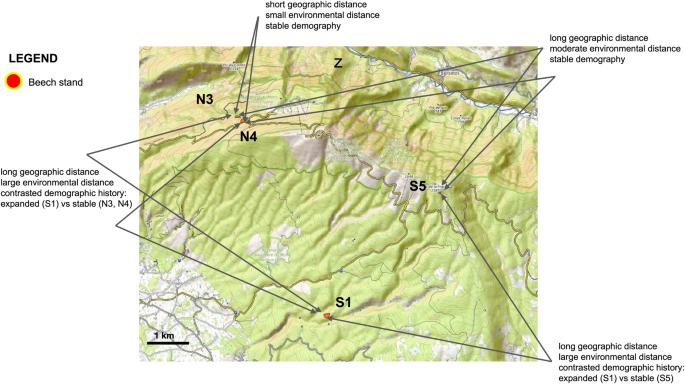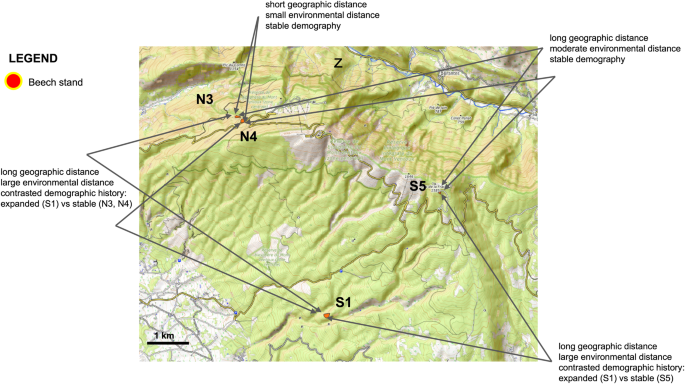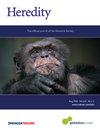滚下那座山:欧洲山毛榉沿陡峭环境梯度快速种群扩张过程中的微地理适应性分化。
IF 3.1
2区 生物学
Q2 ECOLOGY
引用次数: 0
摘要
由于有效种群规模大、基因流动强,森林树木种群具有很高的遗传多样性,使其能够在扩散距离内通过适应当地环境压力而实现多样化。许多树木种群也经历过历史上的人口波动,包括不同时间尺度上的空间种群收缩或扩张,这可能会限制它们适应环境变化的能力。我们的目的是通过研究环境条件反差较大、近期是否扩张的近缘树种之间的适应性差异模式,研究近期的收缩和扩张事件如何干扰当地的适应性。为了在考虑人口因素的同时研究局部适应的全基因组特征,我们分析了一个欧洲山毛榉种群的分化情况,方法是测试四个林分之间来自约9千个基因组区域的约3.5万个单核苷酸多态性的配对分化。我们采用了三种基于不同假设的差异离群点搜索方法,分别针对单个 SNP 或连续基因组区域,同时考虑了种群规模变化对遗传差异的影响。我们在 19 个目标区域发现了 27 个选择性特征信号。假定的适应性分化涉及所有站对。我们在比较老林区和新殖民地时,以及在比较老林区内的林区时,都发现了信号。因此,适应性分化过程既发生在环境对比强烈的短时间内,也发生在长期稳定的种群的短生态梯度上。这表明,长期存在的遗传变异支持局部、微观地理的分化过程,这可以在景观层面维持遗传多样性。本文章由计算机程序翻译,如有差异,请以英文原文为准。


Rolling down that mountain: microgeographical adaptive divergence during a fast population expansion along a steep environmental gradient in European beech
Forest tree populations harbour high genetic diversity thanks to large effective population sizes and strong gene flow, allowing them to diversify through adaptation to local environmental pressures within dispersal distance. Many tree populations also experienced historical demographic fluctuations, including spatial population contraction or expansions at various temporal scales, which may constrain their ability to adapt to environmental variations. Our aim is to investigate how recent contraction and expansion events interfere with local adaptation, by studying patterns of adaptive divergence between closely related stands undergoing environmentally contrasted conditions, and having or not recently expanded. To investigate genome-wide signatures of local adaptation while accounting for demography, we analysed divergence in a European beech population by testing pairwise differentiation among four tree stands at ~35k Single Nucleotide Polymorphisms from ~9k genomic regions. We applied three divergence outlier search methods resting on different assumptions and targeting either single SNPs or contiguous genomic regions, while accounting for the effect of population size variations on genetic divergence. We found 27 signals of selective signatures in 19 target regions. Putatively adaptive divergence involved all stand pairs. We retrieved signals both when comparing old-growth stands and recently colonised areas and when comparing stands within the old-growth area. Therefore, adaptive divergence processes have taken place both over short time spans, under strong environmental contrasts, and over short ecological gradients, in populations that have been stable in the long term. This suggests that standing genetic variation supports local, microgeographic divergence processes, which can maintain genetic diversity at the landscape level.
求助全文
通过发布文献求助,成功后即可免费获取论文全文。
去求助
来源期刊

Heredity
生物-进化生物学
CiteScore
7.50
自引率
2.60%
发文量
84
审稿时长
4-8 weeks
期刊介绍:
Heredity is the official journal of the Genetics Society. It covers a broad range of topics within the field of genetics and therefore papers must address conceptual or applied issues of interest to the journal''s wide readership
 求助内容:
求助内容: 应助结果提醒方式:
应助结果提醒方式:


